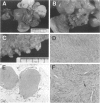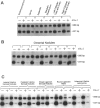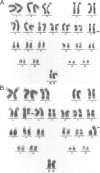Abstract
Disseminated peritoneal leiomyomatosis (DPL, leiomyomatosis peritonealis disseminata) is a rare condition in which multiple histologically benign smooth muscle tumorlets diffusely stud peritoneal and omental surfaces in females, predominantly of reproductive age. Although the distribution of these lesions suggests a metastatic process, DPL generally has a benign clinical course and has been regarded as a metaplastic process. We assessed clonality of 42 tumorlets and 15 normal tissues from four females with DPL by analyzing X chromosome inactivation as indicated by the methylation status of the androgen receptor gene (HUMARA). In each of the four patients, the same parental X chromosome was nonrandomly inactivated in all tumorlets, consistent with a metastatic unicentric neoplasm, or alternatively, selection for an X-linked allele in clonal multicentric lesions. Anomalous demethylation of the marker for X inactivation (HUMARA) was associated with loss of heterozygosity for markers spanning the X chromosome, or monosomy X, in part of one leiomyomatous lesion. Biallelic demethylation of the HUMARA microsatellite polymorphism was also found in one intramural leiomyoma. Two of six DPL lesions karyotyped had cytogenetic abnormalities involving chromosomes 7, 12, and 18, suggesting a pathogenesis in common with uterine leiomyomas.
Full text
PDF


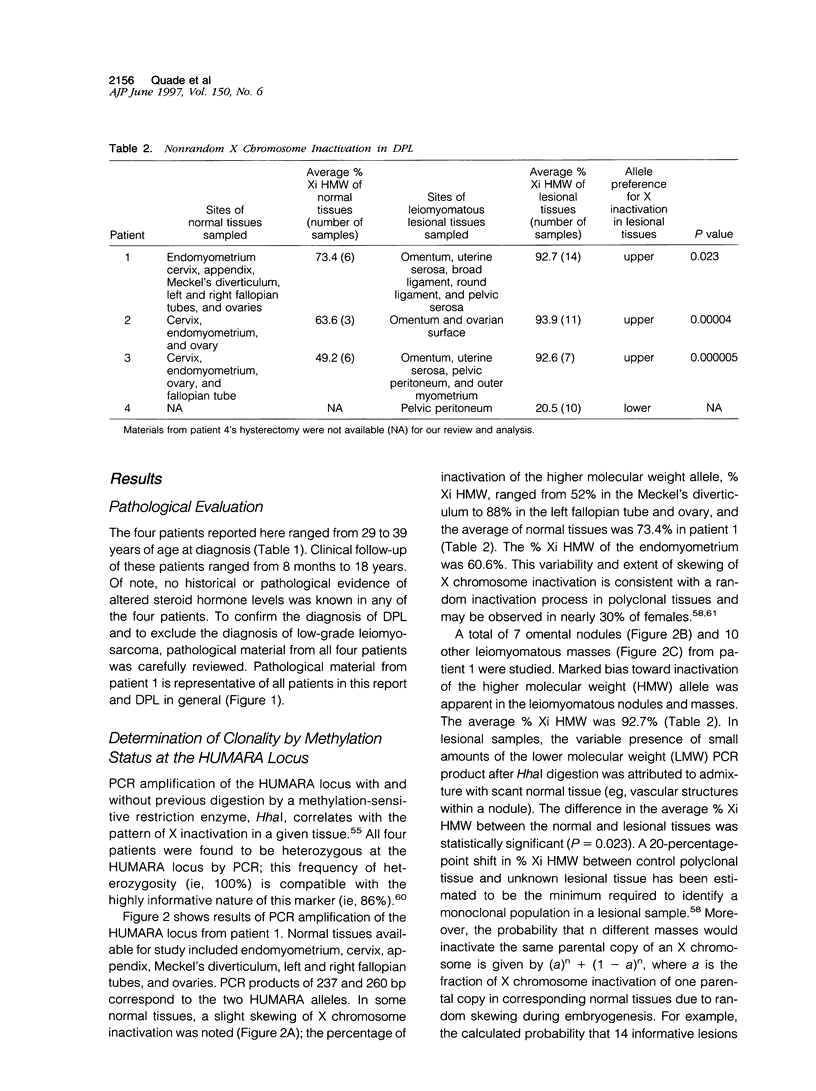
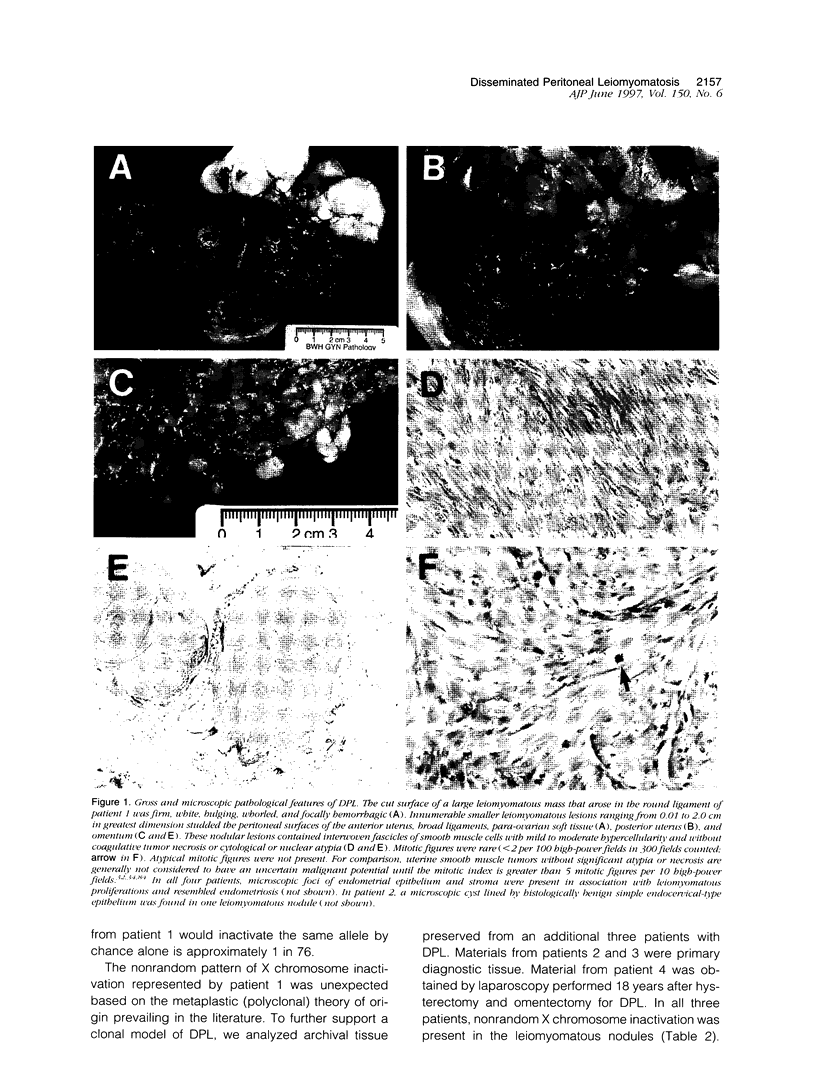
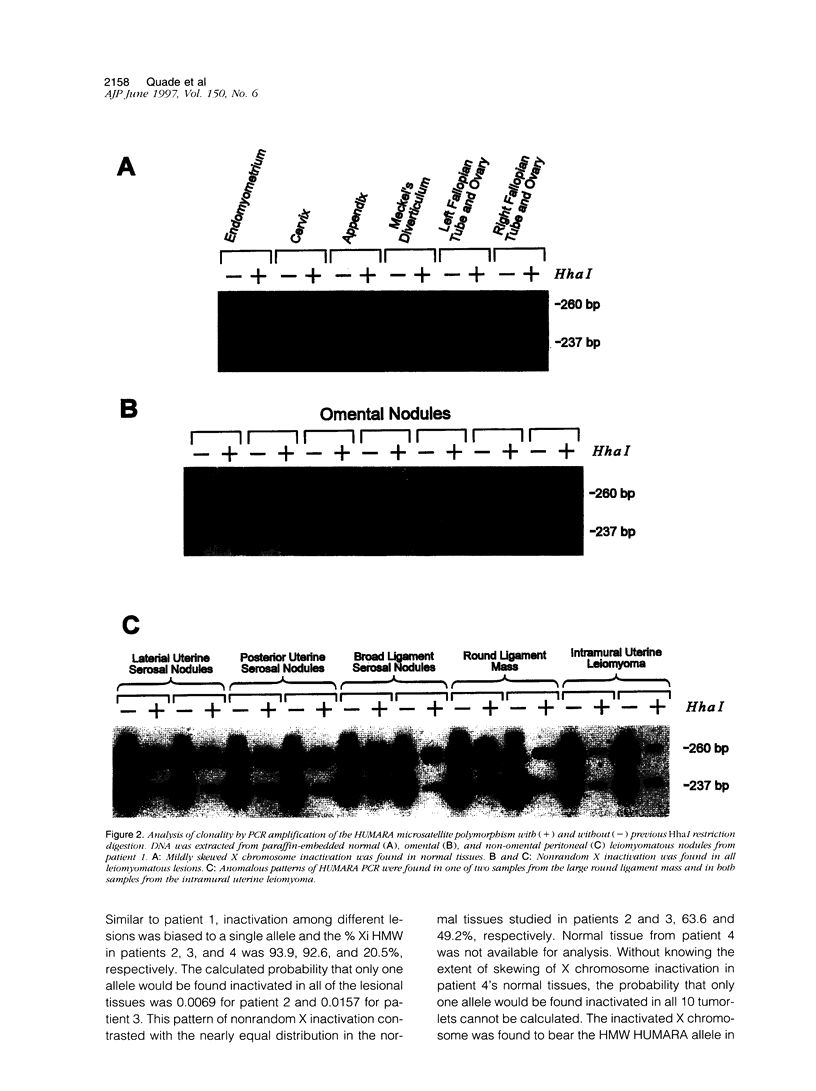
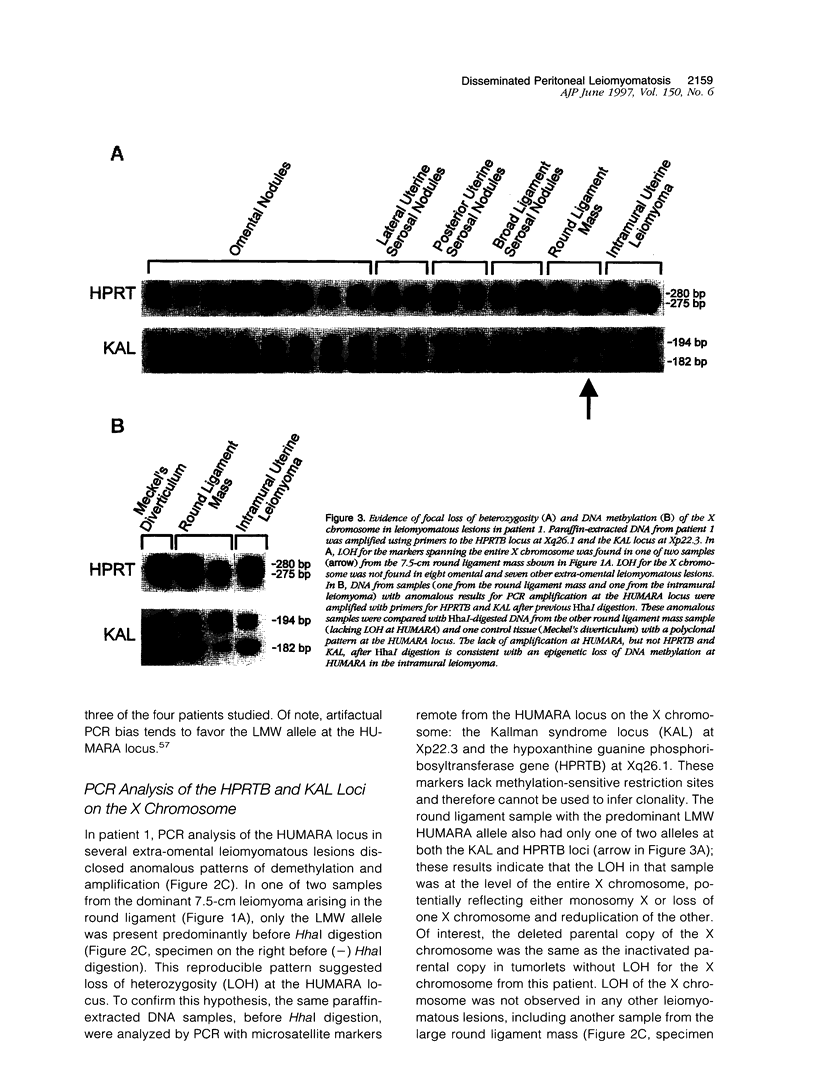
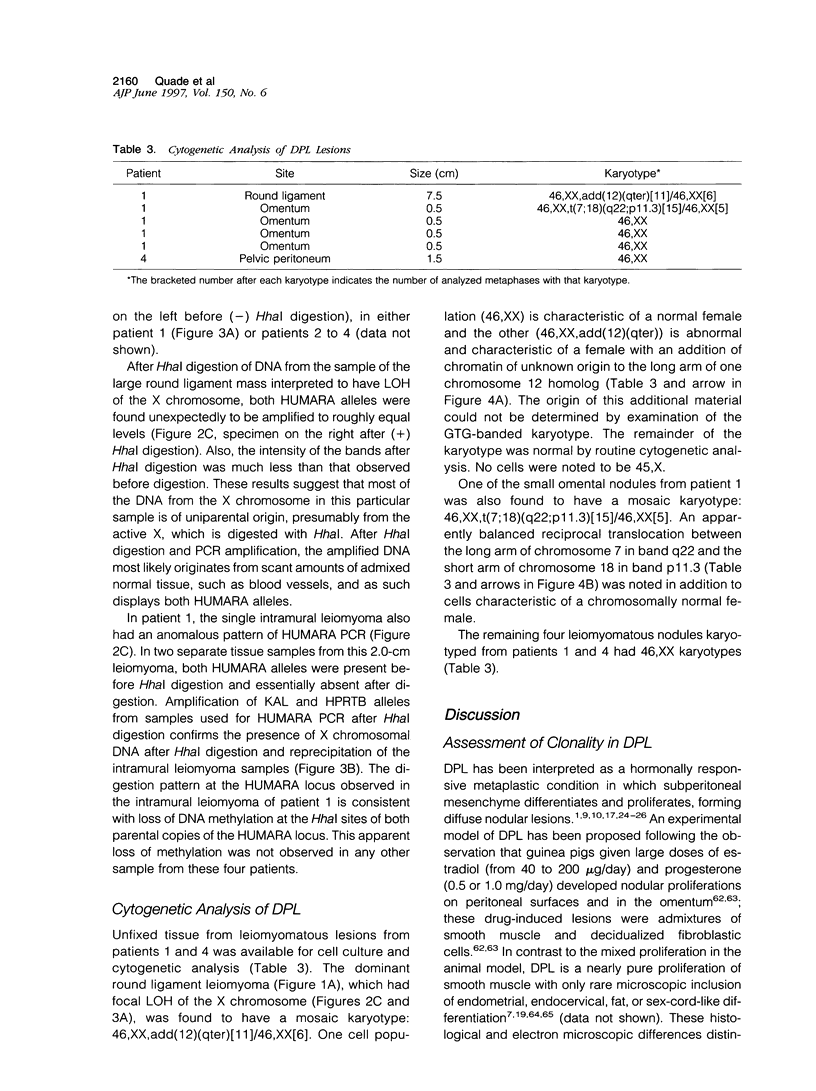

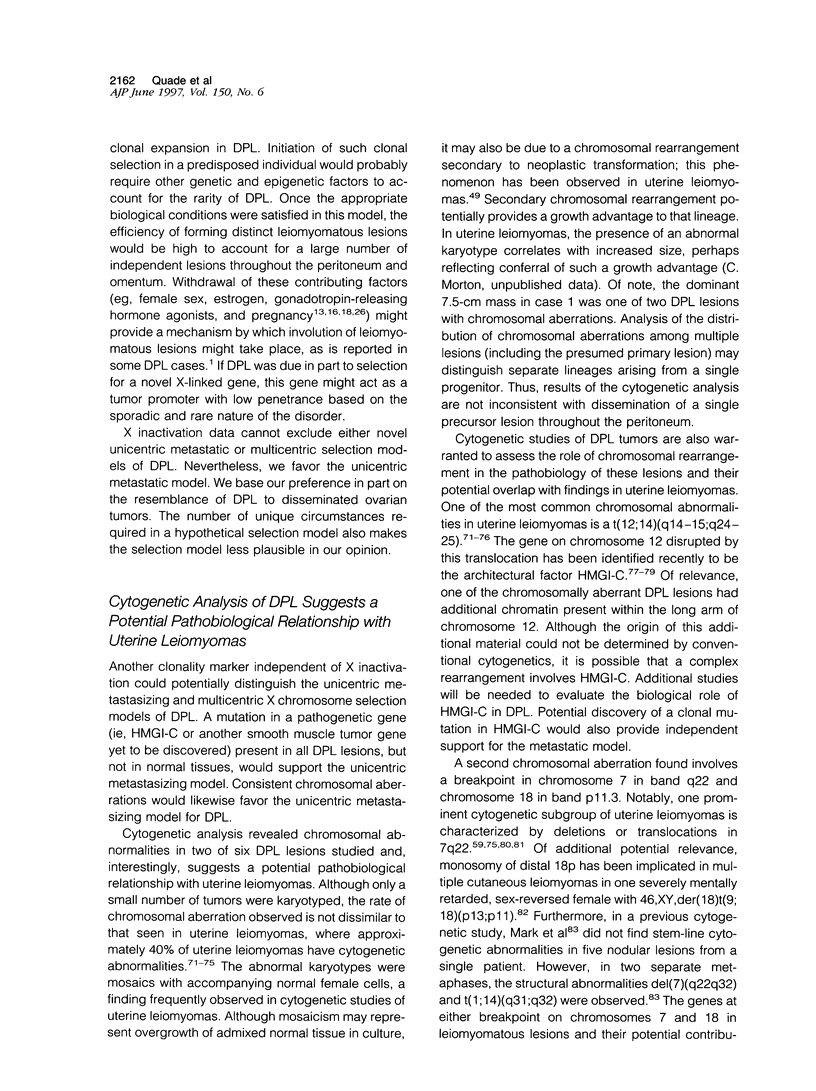
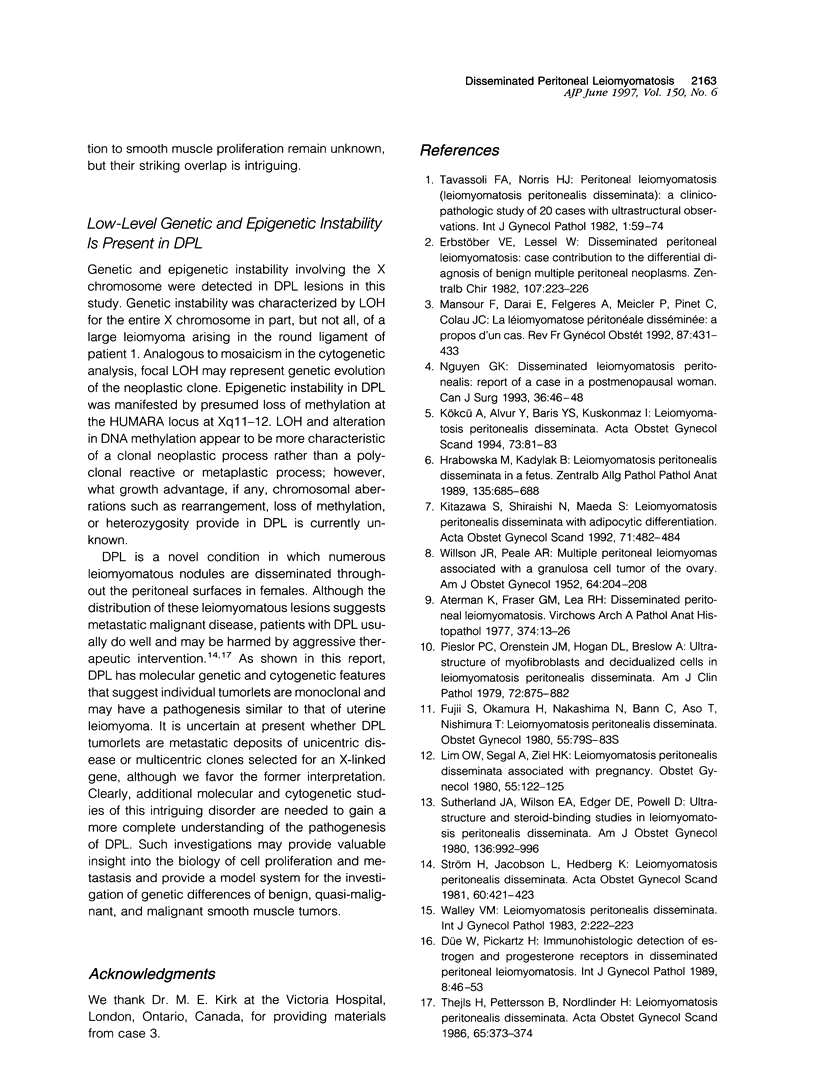
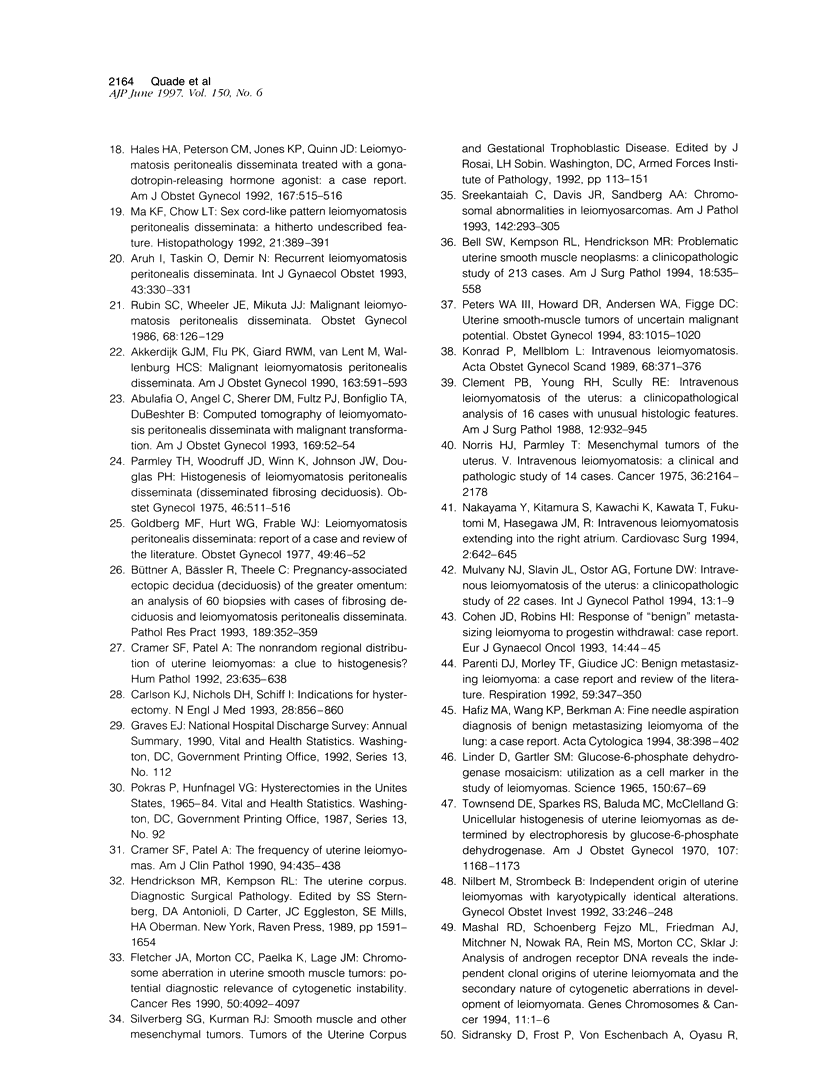
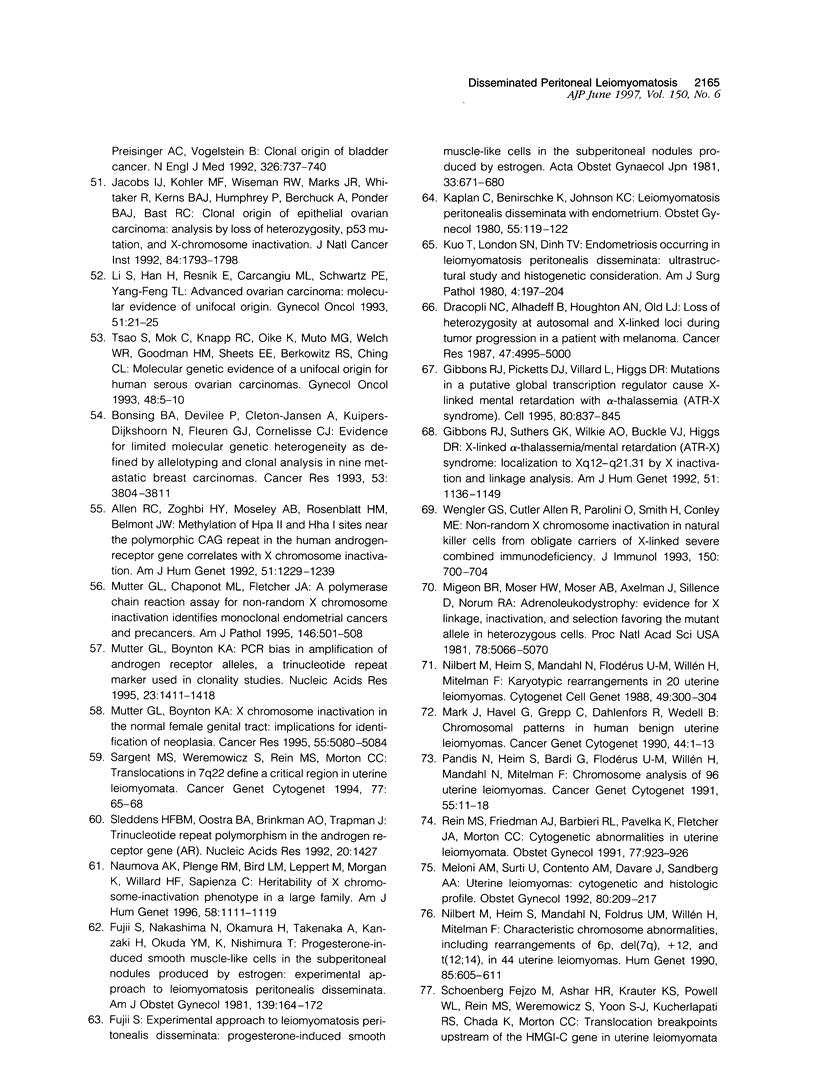
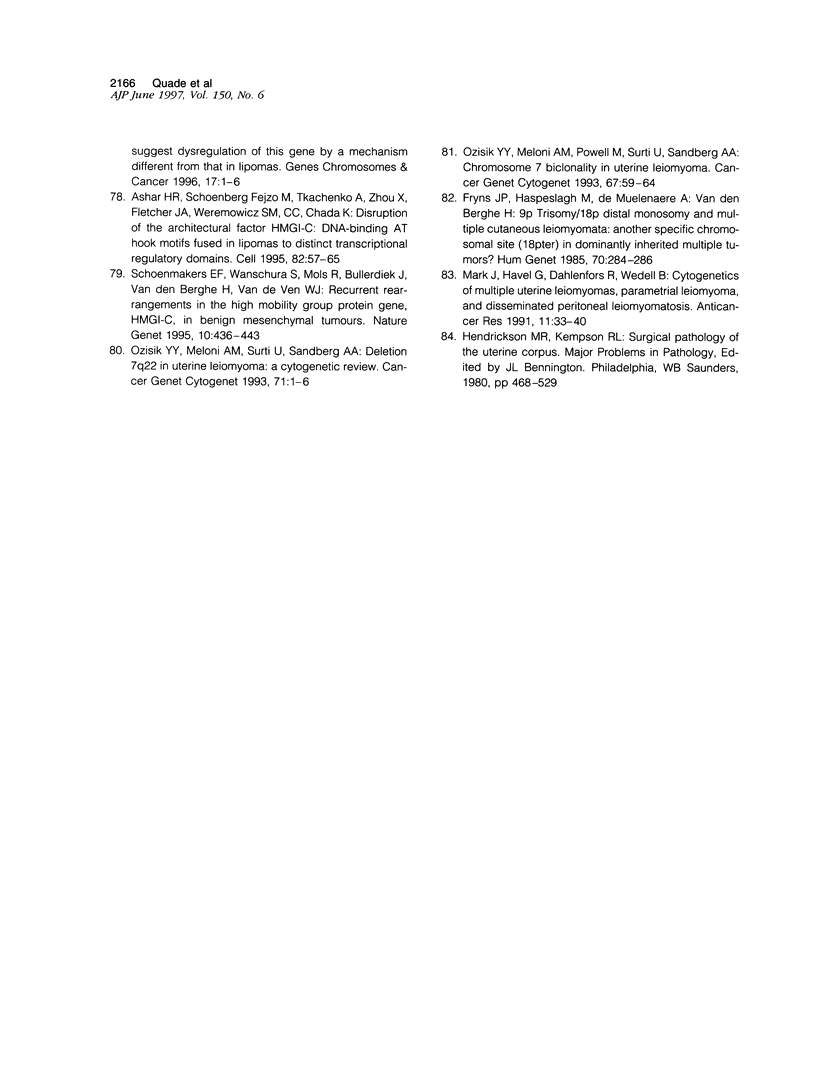
Images in this article
Selected References
These references are in PubMed. This may not be the complete list of references from this article.
- Abulafia O., Angel C., Sherer D. M., Fultz P. J., Bonfiglio T. A., DuBeshter B. Computed tomography of leiomyomatosis peritonealis disseminata with malignant transformation. Am J Obstet Gynecol. 1993 Jul;169(1):52–54. doi: 10.1016/0002-9378(93)90130-b. [DOI] [PubMed] [Google Scholar]
- Akkersdijk G. J., Flu P. K., Giard R. W., van Lent M., Wallenburg H. C. Malignant leiomyomatosis peritonealis disseminata. Am J Obstet Gynecol. 1990 Aug;163(2):591–593. doi: 10.1016/0002-9378(90)91205-q. [DOI] [PubMed] [Google Scholar]
- Allen R. C., Zoghbi H. Y., Moseley A. B., Rosenblatt H. M., Belmont J. W. Methylation of HpaII and HhaI sites near the polymorphic CAG repeat in the human androgen-receptor gene correlates with X chromosome inactivation. Am J Hum Genet. 1992 Dec;51(6):1229–1239. [PMC free article] [PubMed] [Google Scholar]
- Aruh L., Taskin O., Demir N. Recurrent leiomyomatosis peritonealis disseminata. Int J Gynaecol Obstet. 1993 Dec;43(3):330–331. doi: 10.1016/0020-7292(93)90528-5. [DOI] [PubMed] [Google Scholar]
- Ashar H. R., Fejzo M. S., Tkachenko A., Zhou X., Fletcher J. A., Weremowicz S., Morton C. C., Chada K. Disruption of the architectural factor HMGI-C: DNA-binding AT hook motifs fused in lipomas to distinct transcriptional regulatory domains. Cell. 1995 Jul 14;82(1):57–65. doi: 10.1016/0092-8674(95)90052-7. [DOI] [PubMed] [Google Scholar]
- Aterman K., Fraser G. M., Lea R. H. Disseminated peritoneal leiomyomatosis. Virchows Arch A Pathol Anat Histol. 1977 May 13;374(1):13–26. doi: 10.1007/BF00430567. [DOI] [PubMed] [Google Scholar]
- Bell S. W., Kempson R. L., Hendrickson M. R. Problematic uterine smooth muscle neoplasms. A clinicopathologic study of 213 cases. Am J Surg Pathol. 1994 Jun;18(6):535–558. [PubMed] [Google Scholar]
- Bonsing B. A., Devilee P., Cleton-Jansen A. M., Kuipers-Dijkshoorn N., Fleuren G. J., Cornelisse C. J. Evidence for limited molecular genetic heterogeneity as defined by allelotyping and clonal analysis in nine metastatic breast carcinomas. Cancer Res. 1993 Aug 15;53(16):3804–3811. [PubMed] [Google Scholar]
- Büttner A., Bässler R., Theele C. Pregnancy-associated ectopic decidua (deciduosis) of the greater omentum. An analysis of 60 biopsies with cases of fibrosing deciduosis and leiomyomatosis peritonealis disseminata. Pathol Res Pract. 1993 Apr;189(3):352–359. doi: 10.1016/S0344-0338(11)80519-4. [DOI] [PubMed] [Google Scholar]
- Carlson K. J., Nichols D. H., Schiff I. Indications for hysterectomy. N Engl J Med. 1993 Mar 25;328(12):856–860. doi: 10.1056/NEJM199303253281207. [DOI] [PubMed] [Google Scholar]
- Chen J. K., Li L. W., Mioh H. Differential responsiveness of normal and simian virus 40-transformed BALB/c 3T3 cells to retinoic acid: rapid enhancement of epidermal growth factor receptor binding in a simian virus 40-3T3 variant. Cancer Res. 1987 Oct 1;47(19):4995–4999. [PubMed] [Google Scholar]
- Clement P. B., Young R. H., Scully R. E. Intravenous leiomyomatosis of the uterus. A clinicopathological analysis of 16 cases with unusual histologic features. Am J Surg Pathol. 1988 Dec;12(12):932–945. [PubMed] [Google Scholar]
- Cohen J. D., Robins H. I. Response of "benign" metastasizing leiomyoma to progestin withdrawal. Case report. Eur J Gynaecol Oncol. 1993;14(1):44–45. [PubMed] [Google Scholar]
- Cramer S. F., Patel A. The frequency of uterine leiomyomas. Am J Clin Pathol. 1990 Oct;94(4):435–438. doi: 10.1093/ajcp/94.4.435. [DOI] [PubMed] [Google Scholar]
- Cramer S. F., Patel A. The nonrandom regional distribution of uterine leiomyomas: a clue to histogenesis? Hum Pathol. 1992 Jun;23(6):635–638. doi: 10.1016/0046-8177(92)90318-w. [DOI] [PubMed] [Google Scholar]
- Düe W., Pickartz H. Immunohistologic detection of estrogen and progesterone receptors in disseminated peritoneal leiomyomatosis. Int J Gynecol Pathol. 1989;8(1):46–53. doi: 10.1097/00004347-198903000-00006. [DOI] [PubMed] [Google Scholar]
- Erbstösser E., Lessel W. Leiomyomatosis peritonealis disseminata. Ein kasuistischer Beitrag zur Differentialdiagnose gutartiger multipler peritonealer Neubildungen. Zentralbl Chir. 1982;107(4):223–226. [PubMed] [Google Scholar]
- Fletcher J. A., Morton C. C., Pavelka K., Lage J. M. Chromosome aberrations in uterine smooth muscle tumors: potential diagnostic relevance of cytogenetic instability. Cancer Res. 1990 Jul 1;50(13):4092–4097. [PubMed] [Google Scholar]
- Fryns J. P., Haspeslagh M., de Mûelenaere A., van Den Berghe H. 9p Trisomy/18p distal monosomy and multiple cutaneous leiomyomata. Another specific chromosomal site (18pter) in dominantly inherited multiple tumors? Hum Genet. 1985;70(3):284–286. doi: 10.1007/BF00273459. [DOI] [PubMed] [Google Scholar]
- Fujii S., Nakashima N., Okamura H., Takenaka A., Kanzaki H., Okuda Y., Morimoto K., Nishimura T. Progesterone-induced smooth muscle-like cells in the subperitoneal nodules produced by estrogen. Experimental approach to leiomyomatosis peritonealis disseminata. Am J Obstet Gynecol. 1981 Jan 15;139(2):164–172. doi: 10.1016/0002-9378(81)90440-3. [DOI] [PubMed] [Google Scholar]
- Fujii S., Okamura H., Nakashima N., Bann C., Aso T., Nishimura T. Leiomyomatosis peritonealis disseminata. Obstet Gynecol. 1980 Mar;55(3 Suppl):79S–83S. doi: 10.1097/00006250-198003001-00025. [DOI] [PubMed] [Google Scholar]
- Fujii S. [Experimental approach to leiomyomatosis peritonealis disseminata--progesterone-induced smooth muscle-like cells in the subperitoneal nodules produced by estrogen (author's transl)]. Acta Obstet Gynaecol Jpn. 1981 May;33(5):671–680. [PubMed] [Google Scholar]
- Gibbons R. J., Picketts D. J., Villard L., Higgs D. R. Mutations in a putative global transcriptional regulator cause X-linked mental retardation with alpha-thalassemia (ATR-X syndrome). Cell. 1995 Mar 24;80(6):837–845. doi: 10.1016/0092-8674(95)90287-2. [DOI] [PubMed] [Google Scholar]
- Gibbons R. J., Suthers G. K., Wilkie A. O., Buckle V. J., Higgs D. R. X-linked alpha-thalassemia/mental retardation (ATR-X) syndrome: localization to Xq12-q21.31 by X inactivation and linkage analysis. Am J Hum Genet. 1992 Nov;51(5):1136–1149. [PMC free article] [PubMed] [Google Scholar]
- Goldberg M. F., Hurt W. G., Frable W. J. Leiomyomatosis peritonealis disseminata. Report of a case and review of the literature. Obstet Gynecol. 1977 Jan;49(1 Suppl):46–52. [PubMed] [Google Scholar]
- Hafiz M. A., Wang K. P., Berkman A. Fine needle aspiration diagnosis of benign metastasizing leiomyoma of the lung. A case report. Acta Cytol. 1994 May-Jun;38(3):398–402. [PubMed] [Google Scholar]
- Hales H. A., Peterson C. M., Jones K. P., Quinn J. D. Leiomyomatosis peritonealis disseminata treated with a gonadotropin-releasing hormone agonist. A case report. Am J Obstet Gynecol. 1992 Aug;167(2):515–516. doi: 10.1016/s0002-9378(11)91445-8. [DOI] [PubMed] [Google Scholar]
- Hrabowska M., Kadylak B. Leiomyomatosis peritonealis disseminata in a fetus. Zentralbl Allg Pathol. 1989;135(7):685–688. [PubMed] [Google Scholar]
- Jacobs I. J., Kohler M. F., Wiseman R. W., Marks J. R., Whitaker R., Kerns B. A., Humphrey P., Berchuck A., Ponder B. A., Bast R. C., Jr Clonal origin of epithelial ovarian carcinoma: analysis by loss of heterozygosity, p53 mutation, and X-chromosome inactivation. J Natl Cancer Inst. 1992 Dec 2;84(23):1793–1798. doi: 10.1093/jnci/84.23.1793. [DOI] [PubMed] [Google Scholar]
- Kaplan C., Benirschke K., Johnson K. C. Leiomyomatosis peritonealis disseminata with endometrium. Obstet Gynecol. 1980 Jan;55(1):119–122. [PubMed] [Google Scholar]
- Kitazawa S., Shiraishi N., Maeda S. Leiomyomatosis peritonealis disseminata with adipocytic differentiation. Acta Obstet Gynecol Scand. 1992 Aug;71(6):482–484. doi: 10.3109/00016349209021100. [DOI] [PubMed] [Google Scholar]
- Konrad P., Mellblom L. Intravenous leiomyomatosis. Acta Obstet Gynecol Scand. 1989;68(4):371–376. doi: 10.3109/00016348909028675. [DOI] [PubMed] [Google Scholar]
- Kuo T., London S. N., Dinh T. V. Endometriosis occurring in leiomyomatosis peritonealis disseminata: ultrastructural study and histogenetic consideration. Am J Surg Pathol. 1980 Apr;4(2):197–204. doi: 10.1097/00000478-198004000-00012. [DOI] [PubMed] [Google Scholar]
- Kökç A., Alvur Y., Bariş Y. S., Kuşkonmaz I. Leiomyomatosis peritonealis disseminata. Acta Obstet Gynecol Scand. 1994 Jan;73(1):81–83. doi: 10.3109/00016349409013403. [DOI] [PubMed] [Google Scholar]
- Li S., Han H., Resnik E., Carcangiu M. L., Schwartz P. E., Yang-Feng T. L. Advanced ovarian carcinoma: molecular evidence of unifocal origin. Gynecol Oncol. 1993 Oct;51(1):21–25. doi: 10.1006/gyno.1993.1240. [DOI] [PubMed] [Google Scholar]
- Lim O. W., Segal A., Ziel H. K. Leiomyomatosis peritonealis disseminata associated with pregnancy. Obstet Gynecol. 1980 Jan;55(1):122–125. [PubMed] [Google Scholar]
- Linder D., Gartler S. M. Glucose-6-phosphate dehydrogenase mosaicism: utilization as a cell marker in the study of leiomyomas. Science. 1965 Oct 1;150(3692):67–69. doi: 10.1126/science.150.3692.67. [DOI] [PubMed] [Google Scholar]
- Ma K. F., Chow L. T. Sex cord-like pattern leiomyomatosis peritonealis disseminata: a hitherto undescribed feature. Histopathology. 1992 Oct;21(4):389–391. doi: 10.1111/j.1365-2559.1992.tb00416.x. [DOI] [PubMed] [Google Scholar]
- Mansour F., Darai E., Felgeres A., Meicler P., Pinet C., Colau J. C. La léiomyomatose péritonéale disséminée. A propos d'un cas. Rev Fr Gynecol Obstet. 1992 Jul-Sep;87(7-9):431–433. [PubMed] [Google Scholar]
- Mark J., Havel G., Dahlenfors R., Wedell B. Cytogenetics of multiple uterine leiomyomas, parametrial leiomyoma and disseminated peritoneal leiomyomatosis. Anticancer Res. 1991 Jan-Feb;11(1):33–39. [PubMed] [Google Scholar]
- Mark J., Havel G., Grepp C., Dahlenfors R., Wedell B. Chromosomal patterns in human benign uterine leiomyomas. Cancer Genet Cytogenet. 1990 Jan;44(1):1–13. doi: 10.1016/0165-4608(90)90192-d. [DOI] [PubMed] [Google Scholar]
- Mashal R. D., Fejzo M. L., Friedman A. J., Mitchner N., Nowak R. A., Rein M. S., Morton C. C., Sklar J. Analysis of androgen receptor DNA reveals the independent clonal origins of uterine leiomyomata and the secondary nature of cytogenetic aberrations in the development of leiomyomata. Genes Chromosomes Cancer. 1994 Sep;11(1):1–6. doi: 10.1002/gcc.2870110102. [DOI] [PubMed] [Google Scholar]
- Meloni A. M., Surti U., Contento A. M., Davare J., Sandberg A. A. Uterine leiomyomas: cytogenetic and histologic profile. Obstet Gynecol. 1992 Aug;80(2):209–217. [PubMed] [Google Scholar]
- Migeon B. R., Moser H. W., Moser A. B., Axelman J., Sillence D., Norum R. A. Adrenoleukodystrophy: evidence for X linkage, inactivation, and selection favoring the mutant allele in heterozygous cells. Proc Natl Acad Sci U S A. 1981 Aug;78(8):5066–5070. doi: 10.1073/pnas.78.8.5066. [DOI] [PMC free article] [PubMed] [Google Scholar]
- Mulvany N. J., Slavin J. L., Ostör A. G., Fortune D. W. Intravenous leiomyomatosis of the uterus: a clinicopathologic study of 22 cases. Int J Gynecol Pathol. 1994 Jan;13(1):1–9. doi: 10.1097/00004347-199401000-00001. [DOI] [PubMed] [Google Scholar]
- Mutter G. L., Boynton K. A. PCR bias in amplification of androgen receptor alleles, a trinucleotide repeat marker used in clonality studies. Nucleic Acids Res. 1995 Apr 25;23(8):1411–1418. doi: 10.1093/nar/23.8.1411. [DOI] [PMC free article] [PubMed] [Google Scholar]
- Mutter G. L., Boynton K. A. X chromosome inactivation in the normal female genital tract: implications for identification of neoplasia. Cancer Res. 1995 Nov 1;55(21):5080–5084. [PubMed] [Google Scholar]
- Mutter G. L., Chaponot M. L., Fletcher J. A. A polymerase chain reaction assay for non-random X chromosome inactivation identifies monoclonal endometrial cancers and precancers. Am J Pathol. 1995 Feb;146(2):501–508. [PMC free article] [PubMed] [Google Scholar]
- Nakayama Y., Kitamura S., Kawachi K., Kawata T., Fukutomi M., Hasegawa J., Morita R. Intravenous leiomyomatosis extending into the right atrium. Cardiovasc Surg. 1994 Oct;2(5):642–645. [PubMed] [Google Scholar]
- Naumova A. K., Plenge R. M., Bird L. M., Leppert M., Morgan K., Willard H. F., Sapienza C. Heritability of X chromosome--inactivation phenotype in a large family. Am J Hum Genet. 1996 Jun;58(6):1111–1119. [PMC free article] [PubMed] [Google Scholar]
- Nguyen G. K. Disseminated leiomyomatosis peritonealis: report of a case in a postmenopausal woman. Can J Surg. 1993 Feb;36(1):46–48. [PubMed] [Google Scholar]
- Nilbert M., Heim S., Mandahl N., Flodérus U. M., Willén H., Mitelman F. Characteristic chromosome abnormalities, including rearrangements of 6p, del(7q), +12, and t(12;14), in 44 uterine leiomyomas. Hum Genet. 1990 Oct;85(6):605–611. doi: 10.1007/BF00193583. [DOI] [PubMed] [Google Scholar]
- Nilbert M., Heim S., Mandahl N., Flodérus U. M., Willén H., Mitelman F. Karyotypic rearrangements in 20 uterine leiomyomas. Cytogenet Cell Genet. 1988;49(4):300–304. doi: 10.1159/000132682. [DOI] [PubMed] [Google Scholar]
- Nilbert M., Strömbeck B. Independent origin of uterine leiomyomas with karyotypically identical alterations. Gynecol Obstet Invest. 1992;33(4):246–248. doi: 10.1159/000294895. [DOI] [PubMed] [Google Scholar]
- Norris H. J., Parmley T. Mesenchymal tumors of the uterus. V. Intravenous leiomyomatosis. A clinical and pathologic study of 14 cases. Cancer. 1975 Dec;36(6):2164–2178. doi: 10.1002/cncr.2820360935. [DOI] [PubMed] [Google Scholar]
- Ozisik Y. Y., Meloni A. M., Powell M., Surti U., Sandberg A. A. Chromosome 7 biclonality in uterine leiomyoma. Cancer Genet Cytogenet. 1993 May;67(1):59–64. doi: 10.1016/0165-4608(93)90045-n. [DOI] [PubMed] [Google Scholar]
- Ozisik Y. Y., Meloni A. M., Surti U., Sandberg A. A. Deletion 7q22 in uterine leiomyoma. A cytogenetic review. Cancer Genet Cytogenet. 1993 Nov;71(1):1–6. doi: 10.1016/0165-4608(93)90195-r. [DOI] [PubMed] [Google Scholar]
- Pandis N., Heim S., Bardi G., Flodérus U. M., Willén H., Mandahl N., Mitelman F. Chromosome analysis of 96 uterine leiomyomas. Cancer Genet Cytogenet. 1991 Aug;55(1):11–18. doi: 10.1016/0165-4608(91)90229-n. [DOI] [PubMed] [Google Scholar]
- Parenti D. J., Morley T. F., Giudice J. C. Benign metastasizing leiomyoma. A case report and review of the literature. Respiration. 1992;59(6):347–350. doi: 10.1159/000196086. [DOI] [PubMed] [Google Scholar]
- Parmley T. H., Woodruff J. D., Winn K., Johnson J. W., Douglas P. H. Histogenesis of leiomyomatosis peritonealis disseminata (disseminated fibrosing deciduosis). Obstet Gynecol. 1975 Nov;46(5):511–516. [PubMed] [Google Scholar]
- Peters W. A., 3rd, Howard D. R., Andersen W. A., Figge D. C. Uterine smooth-muscle tumors of uncertain malignant potential. Obstet Gynecol. 1994 Jun;83(6):1015–1020. doi: 10.1097/00006250-199406000-00023. [DOI] [PubMed] [Google Scholar]
- Pieslor P. C., Orenstein J. M., Hogan D. L., Breslow A. Ultrastructure of myofibroblasts and decidualized cells in leiomyomatosis peritonealis disseminata. Am J Clin Pathol. 1979 Nov;72(5):875–882. doi: 10.1093/ajcp/72.5.875. [DOI] [PubMed] [Google Scholar]
- Rein M. S., Friedman A. J., Barbieri R. L., Pavelka K., Fletcher J. A., Morton C. C. Cytogenetic abnormalities in uterine leiomyomata. Obstet Gynecol. 1991 Jun;77(6):923–926. [PubMed] [Google Scholar]
- Rubin S. C., Wheeler J. E., Mikuta J. J. Malignant leiomyomatosis peritonealis disseminata. Obstet Gynecol. 1986 Jul;68(1):126–130. [PubMed] [Google Scholar]
- Sargent M. S., Weremowicz S., Rein M. S., Morton C. C. Translocations in 7q22 define a critical region in uterine leiomyomata. Cancer Genet Cytogenet. 1994 Oct;77(1):65–68. doi: 10.1016/0165-4608(94)90151-1. [DOI] [PubMed] [Google Scholar]
- Schoenmakers E. F., Wanschura S., Mols R., Bullerdiek J., Van den Berghe H., Van de Ven W. J. Recurrent rearrangements in the high mobility group protein gene, HMGI-C, in benign mesenchymal tumours. Nat Genet. 1995 Aug;10(4):436–444. doi: 10.1038/ng0895-436. [DOI] [PubMed] [Google Scholar]
- Sidransky D., Frost P., Von Eschenbach A., Oyasu R., Preisinger A. C., Vogelstein B. Clonal origin bladder cancer. N Engl J Med. 1992 Mar 12;326(11):737–740. doi: 10.1056/NEJM199203123261104. [DOI] [PubMed] [Google Scholar]
- Sleddens H. F., Oostra B. A., Brinkmann A. O., Trapman J. Trinucleotide repeat polymorphism in the androgen receptor gene (AR). Nucleic Acids Res. 1992 Mar 25;20(6):1427–1427. doi: 10.1093/nar/20.6.1427-a. [DOI] [PMC free article] [PubMed] [Google Scholar]
- Sreekantaiah C., Davis J. R., Sandberg A. A. Chromosomal abnormalities in leiomyosarcomas. Am J Pathol. 1993 Jan;142(1):293–305. [PMC free article] [PubMed] [Google Scholar]
- Ström H., Jacobson L., Hedberg K. Leiomyomatosis peritonealis disseminata. Acta Obstet Gynecol Scand. 1981;60(4):421–423. doi: 10.3109/00016348109154138. [DOI] [PubMed] [Google Scholar]
- Sutherland J. A., Wilson E. A., Edger D. E., Powell D. Ultrastructure and steroid-binding studies in leiomyomatosis peritonealis disseminata. Am J Obstet Gynecol. 1980 Apr 15;136(8):992–996. doi: 10.1016/0002-9378(80)90624-9. [DOI] [PubMed] [Google Scholar]
- Tavassoli F. A., Norris H. J. Peritoneal leiomyomatosis (leiomyomatosis peritonealis disseminata): a clinicopathologic study of 20 cases with ultrastructural observations. Int J Gynecol Pathol. 1982;1(1):59–74. [PubMed] [Google Scholar]
- Thejls H., Pettersson B., Nordlinder H. Leiomyomatosis peritonealis disseminata. Acta Obstet Gynecol Scand. 1986;65(4):373–374. doi: 10.3109/00016348609157364. [DOI] [PubMed] [Google Scholar]
- Townsend D. E., Sparkes R. S., Baluda M. C., McClelland G. Unicellular histogenesis of uterine leiomyomas as determined by electrophoresis by glucose-6-phosphate dehydrogenase. Am J Obstet Gynecol. 1970 Aug 15;107(8):1168–1173. doi: 10.1016/s0002-9378(15)30365-3. [DOI] [PubMed] [Google Scholar]
- Tsao S. W., Mok C. H., Knapp R. C., Oike K., Muto M. G., Welch W. R., Goodman H. M., Sheets E. E., Berkowitz R. S., Lau C. C. Molecular genetic evidence of a unifocal origin for human serous ovarian carcinomas. Gynecol Oncol. 1993 Jan;48(1):5–10. doi: 10.1006/gyno.1993.1002. [DOI] [PubMed] [Google Scholar]
- WILLSON J. R., PEALE A. R. Multiple peritoneal leiomyomas associated with a granulosa-cell tumor of the ovary. Am J Obstet Gynecol. 1952 Jul;64(1):204–208. doi: 10.1016/s0002-9378(16)38757-9. [DOI] [PubMed] [Google Scholar]
- Walley V. M. Leiomyomatosis peritonealis disseminata. Int J Gynecol Pathol. 1983;2(2):222–223. [PubMed] [Google Scholar]
- Wengler G. S., Allen R. C., Parolini O., Smith H., Conley M. E. Nonrandom X chromosome inactivation in natural killer cells from obligate carriers of X-linked severe combined immunodeficiency. J Immunol. 1993 Jan 15;150(2):700–704. [PubMed] [Google Scholar]



